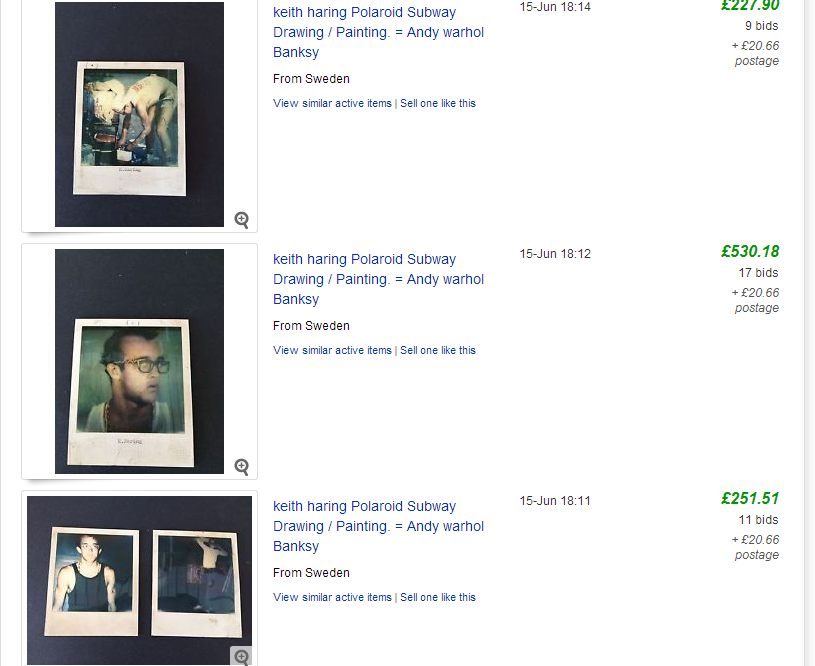Analysis
Dodgy eBay Sellers Peddle Tall Tales and Fake Art
Does eBay go far enough to protect the ignorant?

Does eBay go far enough to protect the ignorant?

Eileen Kinsella

Several online art sale scams recently uncovered on eBay have underscored the need for buyers to be vigilant when shelling out money for works online. Stories invented whole cloth about the provenance, or ownership history, of a work, right down to questionable forms of authentication documents, have been used to peddle purportedly authentic Jackson Pollocks, Keith Harings, and Andy Warhols alongside other well known artists.
To be sure, even top auction houses, online auctioneers, and respected dealers are not immune to the problems of fakes and forgeries. Just look at the recent Knoedler scandal, whereby one of Manhattan’s oldest and most respected galleries sold multimillion dollar paintings as the work of Abstract Expressionist masters, and the works turned out to have been painted by a forger in Queens.
But eBay is such a vast auction platform, and many of its would-be buyers not as savvy as seasoned collectors who buy frequently from reputable auction houses or galleries and know what to look for. Thus they are potentially much bigger and easier targets for someone with a good story about how a work was “discovered,” and more easily duped into believing they have stumbled onto a hidden treasure.
The FBI Arrests Re
The FBI recently arrested John D. Re of East Hampton for allegedly selling fake Pollock paintings privately and on eBay–more than 60 pieces for almost $1.9 million–starting in 2005. A small group of clients all bought Re’s story that a cache of Pollock paintings had been discovered in the cleaning-out of an East Hampton woman’s basement in 1999. Forensic analysis and reviews by the International Foundation for Art Research (IFAR) later concluded all were fake.
Along similar lines, a report in the Telegraph last week identified Geoffrey Spilman, the son of a vicar in Rugby, Warwickshire, as being behind the sale of a slew of fake paintings on eBay, said to be by artists including LS Lowry, Adrian Heath, and Mary Fedden. Spilman, 48, is churning out three pictures a week and selling them online from his modest flat, for several hundreds of pounds each, according to the report. They come with forged signatures, the report states. In recent months, Spilman has told potential buyers that the works belonged to his late father or were found in a house clearance or art fair, and that, due to a lack of paperwork, their provenance could not be guaranteed. In reality, he is suspected of having painted many of the works himself, the report states.
And artnet news was recently contacted by Charles Uzzell Edwards, owner of London’s Pure Evil Gallery, who happened upon a substantial inventory of little-known 1980s Pop art ephemera on eBay, being sold by a Swedish seller just over two months ago. The online find included subway drawings attributed to Haring as well as Polaroids said to be by Warhol. Edwards bought some pieces online, and then negotiated to buy a larger group of works from the Swede, who sells under the username bobinga33 and eventually identified himself to Edwards as Patrick Maske. Maske claims that the works belonged to his late father. Edwards, who originally planned to offer the works for sale through his gallery, now believes the works are not authentic and has withdrawn them for sale.

The eBay page of Bobinga33 aka Patrick Maske, lists more than 50 Pop art works.
So what’s an art loving virtual bidder to do?
In light of these thorny art buying situations, we reached out to eBay to ask what its policy is about selling art online. We were impressed and somewhat surprised to learn that its policy is specific and relatively thorough. Falling under the category “Not Allowed” are: “Disclaiming knowledge of, or responsibility for, the authenticity or legality of an item that you describe as genuine; Describing or marketing any item as genuine if you cannot provide reasonable evidence to prove its authenticity; Knowingly participating in any way in the advertisement or sale of any work of art using any deceptive practices, including, but not limited to, false or misleading claims of the item’s scarcity, value, provenance, condition or investment potential.”
There are also specific restrictions regarding selling reproductions and exact replicas, including labeling them as such. But not surprisingly dishonest sellers are still finding a way around the rules.
When contacted by artnet News, Maske, even while pushing the story about his father as a private collector, cited eBay’s policy: “Ebay has some rules that you must be able to verify the authenticity.” But he claims he has been open about the fact that he does not actually have paperwork to substantiate authenticity.
Maske said, “Whenever I’ve listed something on Ebay, I’ve written that I have no purchase ticket or any other paperwork to accompany the item. That’s why the listings are starting with one dollar. It’s the only thing I posted and no certificate is included with the auction, and that the object is sold under the mannerism of the artist ‘as is.’”
Asked about instances such as this, Ryan Moore, lead manager of business communications for eBay said: “Sellers are not allowed to describe any item as genuine if they cannot provide reasonable evidence to prove its authenticity. Instances you describe are subject to review when reported and potential removal of the listing,” under the above cited policies.
Certainly Re, who was formerly convicted and imprisoned for printing counterfeit bills, according to a detailed news report in the East Hampton Star, used the story about a basement find to his advantage while also simultaneously brandishing an easy excuse about why there was no paperwork to back up the Pollocks. According to the story, Re told FBI agent Meredith Savona, of the bureau’s art theft and art fraud division, that he had never sold any of the purported Pollocks as “authentic.” She then “confronted him with the records of his eBay transactions, in which he told bidders that the paintings were real,” according to the report.
As for Spilman, after being contacted by the Telegraph with its findings, eBay shut down Spilman’s activities and banned him from eBay for life. A spokesman said: “We have reviewed three accounts and determined that the seller has not lived up to the high standards we expect.” In addition to the fact that Spilman was suspected of operating multiple accounts, among other damning details, one of the painters whose work was forged, Ashley Jackson, 73, complained to his local police department after spotting a work he said was not his.
eBay’s Response
Moore said, “eBay aggressively detects and removes members who engage in any type of fraudulent behavior. . . . eBay has partnered with select experts in the field to advise on any potential fraudulent listings. Additionally we value the pivotal role our community members play in the detection of unauthentic listings, and encourage them to continue bringing listings that are perceived to be fraudulent to our attention through the ‘Report Item’ link or form.” Moore said such reports are followed by “a detailed review and vetted by our teams, and listings deemed fraudulent will be removed promptly.”
Asked about the timing of reviews after suspicious activity is reported, Moore said reviews “are typically within 24 hours after receiving the report. Sellers in violation of our Selling Art Policy may be subject to a range of actions, including listing removal, restrictions and suspension of their account.”
Asked for information about Re and the fake Pollocks, Moore said: “As a general policy, eBay cannot comment on the specific matters of ongoing investigations.”